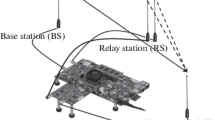Abstract
Performance of present-generation wireless communication, long term evolution (LTE) is greatly affected by bit error rate (BER). So, objective of this paper is to present a quantitative performance comparison of different modulation techniques based on parameters, BER at different level of signal to noise ratio (SNR) and utilized bandwidth by using different level of correlation in multiple input multiple output (MIMO). The comparative analysis has been done by considering LTE support bandwidths of 1.4, 3, 5, 10, 15 and 20 MHz. This LTE based simulation work for urban areas in a fast moving environment is performed on the basis of different antenna arrays like 2 × 2 and 4 × 4. Comparative evaluation in form of graphical results shows that BER is relatively very low at low level correlation of MIMO and LTE system performance based on the parameter BER is better at 10 MHz bandwidth.









Similar content being viewed by others
References
Sesia, S., Toufik, I., & Baker, M. (2009). LTE: The UMTS long term evolution (pp. 1–4). NewYork: Wiley.
ETSI TR 136 913 V10.0.0, (2011) LTE; requirements for further advancements for evolved universal terrestrial radio access (E-UTRA) (LTE-Advanced)”, 3GPP TR 36.913 version 10.0.0 Release 10, European Telecommunications Standards Institute Technical Report, pp. 8. http://www.etsi.org/deliver/etsi_tr\136900_136999\136913\10.00.00_60\tr_136913v100000p.pdf.
Joung, J., Ho, C. K., & Sun, S. (2014). Spectral efficiency and energy efficiency of OFDM systems: Impact of power amplifiers and countermeasures. IEEE Journal on Selected Areas in Communications, 32(2), 208–220.
Yigit, H., Kavak, A., & Kucuk, K. (2010). Capacity improvement for TDD-MIMO systems via AR modeling based linear prediction. Wireless Personal Communications, 52(2), 411–418.
Martín-Sacristán, D., Monserrat, J. F., Cabrejas-Penuelas, J., Calabuig, D., Garrigas, S., & Cardona, N. (2009). On the way towards fourth-generation mobile: 3GPP LTE and LTE-advanced. EURASIP Journal on Wireless Communications and Networking, 2009, 1–10. doi:10.1155/2009/354089.
Shiu, D. S., Foschini, G. J., Gans, M. J., & Kahn, J. M. (2000). Fading correlation and its effect on the capacity of multi-element antenna systems. IEEE Transaction on Communication, 48(3), 502–513.
Büyükçorak, S., & Kurt, G. K. (2012). Spatial correlation and MIMO capacity at 2.4 GHz. Procedia Technology, 3, 9–17. doi:10.1016/j.protcy.2012.03.002.
Lee, W., Lee, I., Kwak, J. S., Ihm, B. C., & Han, S. (2012). Multi-BS MIMO cooperation: Challenges and practical solutions in 4G systems. IEEE Wireless Communications Magazine, 19(1), 89–96.
Nobandegani, K. S., & Azmi, P. (2010). A study of the extreme effects of fading correlation and the impact of imperfect MMSE channel estimation on the performance of SIMO zero-forcing receivers and on the capacity-maximizing strategy in SIMO links. IEEE Transactions on Vehicular Technology, 59(3), 1294–1306.
Vagenas, E., Paschos, G. S., & Kotsopoulos, S. A. (2011). Beamforming capacity optimization for MISO systems with both mean and covariance feedback. IEEE Transactions on Wireless Communications, 10(9), 2994–3001.
Nguyen, T. T., Nguyen, V. T., Hoang, T. A., Nguyen, T. M., & Dang, K. L. (2012). Performance comparisons of detector algorithms for high data rate MIMO–OFDM systems in frequency selective fading channel. IEEE International Symposium on Signal Processing and Information Technology (ISSPIT), pp. 1–5. doi:10.1109/ISSPIT.2012.6889111.
Ozcelik, H., Herdin, M., Hofstetter, H., & Bonek, E. (2003). Capacity of different MIMO systems based on indoor measurements at 5.2 GHz. In proceedings on IEEE Personal Mobile Communications Conference (5th European Conf. Publ. No. 492), pp. 463–466, doi: 10.1049/cp:20030298.
Hsieh, P. C., & Chen, F. C. (2009). A new spatial correlation formulation of arbitrary AoA scenarios. IEEE Antennas and Wireless Propagation Letters, 8, 398–401. doi:10.1109/LAWP.2009.2019311.
Werner, K., Jansson, M., & Stoica, P. (2008). On estimation of covariance matrices with Kronecker product structure. IEEE Transactions on Signal Processing, 56(2), 478–491.
Cho, Y. S., Kim, J., Yang, W. Y., & Kang, C. G. (2010). MIMO–OFDM wireless communications with MATLAB (pp. 84–88). NewYork: Wiley.
Molteni, D., Nicoli, M., & Spagnolini, U. (2011). Performance of MIMO–OFDMA systems in correlated fading channels and non-stationary interference. IEEE Transactions on Wireless Communications, 10(5), 1480–1494.
Kim, H. S., & Daneshrad, B. (2010). Energy-constrained link adaptation for MIMO OFDM wireless communication systems. IEEE Transactions on Wireless Communications, 9(9), 2820–2832.
Morales-Jiménez, D., Paris, J. F., & Entrambasaguas, J. T. (2009). Performance tradeoffs among low-complexity detection algorithms for MIMO–LTE receivers. International Journal of Communication Systems, Wiley InterScience, 22(7), 885–897.
Ketonen, J., Juntti, M., & Cavallaro, J. R. (2010). Performance—complexity comparison of receivers for a LTE MIMO–OFDM system. IEEE Transactions on Signal Processing, 58(6), 3360–3372.
Astely, D., Dahlman, E., Furuskar, A., Jading, Y., Lindstrom, M., & Parkvall, S. (2009). LTE: The evolution of mobile broadband. IEEE Communication Magazine, 47(4), 44–51.
Qulanet Simulator, Scalable Network Technologies (2012). www.qualnet.com.
Goldsmith, A. (2005). Wireless communications (pp. 25–30, 47, 82). Cambridge: Cambridge University Press.
Author information
Authors and Affiliations
Corresponding author
Appendix: Mathematical Calculation of Kronecker Product of Eq. (2)
Appendix: Mathematical Calculation of Kronecker Product of Eq. (2)
Let us Consider, the easiest set up of 2 × 2 correlated structure of MIMO to calculate the Kronecker product of complex correlation matrix of UE and eNB.
Taking a correlation matrix for UE as
and correlation matrix for eNB as
Then Kronecker product of above two matrices is given by
Rights and permissions
About this article
Cite this article
Ghosh, S. Performance Evaluation of Different Coding and Modulation Scheme in LTE Using Different Bandwidth and Correlation Levels. Wireless Pers Commun 86, 563–578 (2016). https://doi.org/10.1007/s11277-015-2945-6
Published:
Issue Date:
DOI: https://doi.org/10.1007/s11277-015-2945-6




